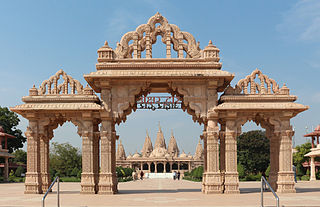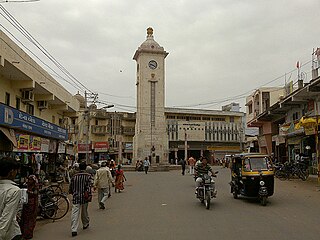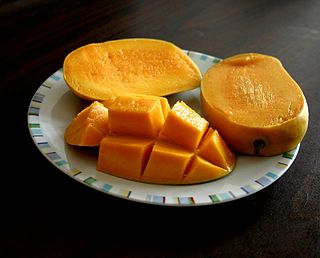

Bhalia Wheat, also known as Daudkhani Wheat is a type of long grain Wheat cultivated in Bhal region in the north of Gulf of Khambhat, Gujarat, India. It received registration as Geographic Indication in 2011. [1]


Bhalia Wheat, also known as Daudkhani Wheat is a type of long grain Wheat cultivated in Bhal region in the north of Gulf of Khambhat, Gujarat, India. It received registration as Geographic Indication in 2011. [1]
Bhal region is situated between Ahmedabad and Bhavnagar districts [2] where this wheat are cultivated starting much before independence of India. [3] They are widely cultivated in Dhandhuka, Dholka and Bavla talukas of Ahmedabad district; Limbdi of Surendranagar district; Vallabhipur of Bhavnagar district; Tarapur and Khambhat of Anand district; Matar of Kheda district; Jambusar and Vagra of Bharuch district. [4]
Bhalia Wheat were registered as Geographic Indication in 2011 with help of state-run Gujarat Agro Industries Corporation and Anand Agricultural University. They are widely used for preparing semolina which is used for making pasta, macaroni, pizza, spaghetti, vermicelli, noodles etc. Gujarat Wheat-1, a variety of Bhalia Wheat, is popular in Gujarat. [4]
The sowing starts in late October to the first week of November after rain water gets drained to the gulf. The produce is reaped in March — April. Every year 1.7 to 1.8 Lakh (170,000 to 180,000 long tons) of wheat is produced across 2 lakh hectares (490,000 acres). Bhalia wheat does not require irrigation or rain as they are cultivated on conserved soil moisture. [4]
Bhalia Wheat are rich in gluten, a type of amino acid. It is also rich in protein. It has high amount of carotene and has low absorption of water. [4] [5]

Gujarat is a state along the western coast of India. Its coastline of about 1,600 km (990 mi) is the longest in the country, most of which lies on the Kathiawar peninsula. Gujarat is the fifth-largest Indian state by area, covering some 196,024 km2 (75,685 sq mi); and the ninth-most populous state, with a population of 60.4 million in 2011. It is bordered by Rajasthan to the northeast, Dadra and Nagar Haveli and Daman and Diu to the south, Maharashtra to the southeast, Madhya Pradesh to the east, and the Arabian Sea and the Pakistani province of Sindh to the west. Gujarat's capital city is Gandhinagar, while its largest city is Ahmedabad. The Gujaratis are indigenous to the state and their language, Gujarati, is the state's official language.

Saurashtra, also known as Kathiawar, is a peninsular region of Gujarat, India, located on the Arabian Sea coast. It covers about a third of Gujarat state, notably 11 districts of Gujarat, including Rajkot District. It was formerly a state of India before it merged with Bombay state. In 1961 it separated from Bombay and joined Gujarat.

Bhavnagar is a city and the headquarters of Bhavnagar district in the Indian state of Gujarat. It was founded in 1723 by Bhavsinhji Gohil. It was the capital of Bhavnagar State, which was a princely state before it was merged into the Indian Union in February 1948.

Anand is a city and the administrative centre of Anand District in the state of Gujarat, India. It is administered by Anand Municipal Corporation. It is part of the region known as Charotar, consisting of Anand and Kheda districts. Anand is Former Part Of Kaira District in British Raj.

Khambhat, also known as Cambay, is a city and the surrounding urban agglomeration in Anand district in the Indian state of Gujarat. It was once an important trading center, but its harbour gradually silted up, and the maritime trade moved to Surat. Khambat lies on an alluvial plain at the north end of the Gulf of Khambhat, noted for the extreme rise and fall of its tides, which can vary as much as thirty feet in the vicinity of Khambat. Khambat is known for its halvasan sweet, sutarfeni, akik stone and kites (patang), and for sources of oil and gas.

Anand District is an administrative district of Gujarat state in western India and whose popular nickname is Charotar. It was carved out of the Kheda district in 1997. Anand is the administrative headquarters of the district. It is bounded by Kheda District to the north, Vadodara District to the east, Ahmedabad District to the west, and the Gulf of Khambhat to the south. Major towns are Umreth, Khambhat, Karamsad, Tarapur, Petlad, Borsad and Sojitra.

Blackbuck National Park is a national park in India located at Velavadar in the Bhavnagar District of Gujarat state, India.
Dhandhuka is a city and a municipality in the Ahmedabad district in the state of Gujarat, India. Moreover, it is a part of the Bhal region.
Dholera is a town in Ahmedabad district of Gujarat state in India.
Gujarat State Road Transport Corporation abbreviated (GSRTC), is a Government State Transport Undertaking of Gujarat for passengers facilitating with road public transport in moffusil / city services. GSRTC operates within the state of Gujarat, India and neighboring states. It has a fleet of 8322 buses.

Gujarat is a state located in western India. Its north-western border, which is also the international border, is adjacent to Pakistan. Rajasthan and Madhya Pradesh are the states located in its north and north-east respectively. Maharashtra is to its south. The Arabian Sea forms its western-southern boundary. Dadar and Nagar-Haveli are on its southern border.

The Bhal region is an area of Gujarat, India. It is spread across the political boundaries of the districts of Bhavnagar, Ahmedabad, and Anand. The Bhal region is situated on the deltas of the Sabarmati, Bhogawo, Bhadar, Lilka and other rivers that flow east and southeast off the Kathiawar peninsula into the Gulf of Cambay. The word Bhaal seems to have been derived from the Sanskrit word भाल which means forehead. Such a name is given to this region probably because it is mostly as flat as a forehead with almost entire region's soil without any stones, pebbles or gravel.

Anand Junction is a major junction located in Anand, Gujarat. It is a junction on the railway line which connects Ahmedabad with Vadodara and Mumbai and was opened in 1901.
Bhavnagar Taluka is a taluka of Bhavnagar District, state of Gujarat, India. It was named after the largest city in the district, Bhavnagar which is also the administrative headquarters for the taluka, as well as the district.

Sankheda furniture is colourful teak wood furniture of Gujarat, India, treated with lacquer and painted in traditional bright shades of maroon and gold. It is made in Sankheda village and hence its name. The village is located about 45 kilometres (28 mi) from Vadodara.

The 'Gir Kesar' mango, also called Kesar, is a mango cultivar grown in the foothills of Girnar in Gujarat, western India. The mango is known for its bright orange colored pulp and was given the geographical indication status in 2011. The biggest market of Gir Kesar is in Talala Gir known as a Mango Market Yard.
Khambhat railway station is a railway station on the Western Railway network in the state of Gujarat, India. DEMU trains start from Khambhat railway station. Khambhat railway station is well connected by rail to Anand Junction.
Dholera is a taluka in Ahmedabad district of Gujarat state in the western part of India. Situated within the Ahmedabad district, Dholera Taluka is characterized by its strategic positioning along the Gulf of Khambhat, approximately 30 kilometers south of the city of Ahmedabad. Dholera is the headquarters of this taluka.
Mangalwedha jowar is a variety of sorghum cultivated in the Indian state of Maharashtra. Maldandi jowar is traditional variety of grain and widely cultivated crop in the Mangalwedha taluka of Solapur district. ICRISAT developed several new varieties by incorporating genes from the Mangalwedha Maldandi (M-35-1) strain.